Installation and Usage of 4G Redial & Reconnection Tool
Notes
Current Version: A
Revision History
| Version | Description | Date |
|---|---|---|
| A | Initial Version | 2025.03.27 |
1 Overview
This document describes how to install and use the 4G Redial & Reconnection Tool on ED-IPC and ED-HMI series devices.
1.1 Background
Some users of ED-IPC and ED-HMI series devices experience unstable 4G connectivity due to failures in automatic redial after disconnections. To address this, we developed the 4G Redial & Reconnection Tool to ensure reliable 4G reconnection. Our 4G Redial & Reconnection Software Package supports dialing via Quectel-CM or NetworkManager, with the following key features:
- Supports automatic 4G reconnection
- Controls 4G status LEDs
- Customizes 4G network names
- Adds dependency on gpiod (for GPIO control)
- Configures APN (Access Point Name)
TIP
- The tool defaults to using Quectel-CM for dialing, with DEBUG mode disabled.
- The tool will undergo continuous development and updates.
1.2 Applicability
This guide applies to all ED-IPC and ED-HMI series devices with 4G functionality. The specific product models included are as follows:
| Product Series | Model |
|---|---|
| ED-IPC | ED-IPC2000 ED-IPC2100 ED-IPC2200 ED-IPC2400 ED-IPC2600 ED-CM4SEN ED-CM4IND |
| ED-HMI | ED-HMI2020-070C ED-HMI2020-101C ED-HMI2120-070C ED-HMI2120-101C ED-HMI2220-070C ED-HMI2220-101C ED-HMI2630-101C |
2 Configuration Guide
The following steps use the ED-IPC2100 as an example to demonstrate installation and usage.
2.1 Installing the 4G Redial & Reconnection Tool
TIP
If an older version of the tool is already installed, simply install the new version—no uninstallation is required.
Preparation:
- The ED-IPC2100 has a properly installed 4G module, antenna, and active SIM card.
- A 12V 2A power adapter (3.5mm Phoenix connector) and Ethernet cable are ready.
Steps:
Ensure the ED-IPC2100 is powered on and connected to the network.
Add the edatec apt source by executing the following commands in the terminal.
curl -sS https://apt.edatec.cn/pubkey.gpg | sudo apt-key add -
echo "deb https://apt.edatec.cn/raspbian stable main" | sudo tee /etc/apt/sources.list.d/edatec.list
sudo apt update
WARNING
If line breaks appear when pasting copied commands, remove them and replace with spaces at those positions.

- Execute the following command to install the 4G Redial & Reconnection Software Package.
sudo apt install -y ed-ec20-qmi ed-lte-tools

Execute the following command to verify the installation of the 4G Redial & Reconnection Software Package. Successful installation is confirmed if the output matches the content highlighted in the red box within the accompanying figure.

2.2 Using the 4G Redial & Reconnection Tool to Connect to the Network
This section explains how to use the 4G Redial & Reconnection Tool on the device.
2.2.1 Without APN Configuration
After installing the 4G Redial & Reconnection Tool, SIM cards that do not require APN configuration will automatically connect to the 4G network. Connection status can be verified through the following indicators:
- 4G LED indicator is on: Indicates a successful 4G connection.
- 4G LED indicator is off: Indicates no network connection.
Additionally, use the ifconfig command to check if the wwan interface is assigned an IP address, as shown in the figure below. An assigned IP confirms the 4G network is active.
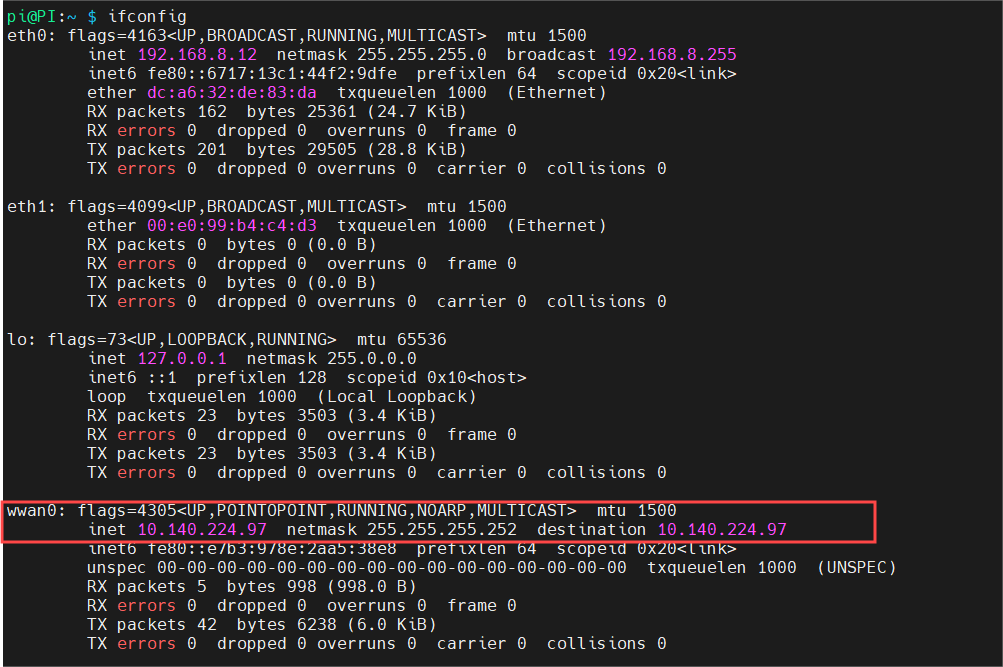
2.2.2 With APN Configuration
After installing the 4G Redial & Reconnection Tool, SIM cards requiring APN configuration must modify the tool’s configuration file and restart the device.
Steps:
- Execute the following command to access the configuration file.
sudo nano /usr/share/ed-lte-tools/ed_config.ini
- As shown in the figure below, enter the APN value after
apn=and save the file. The APN value must be customized by the user based on their carrier settings.
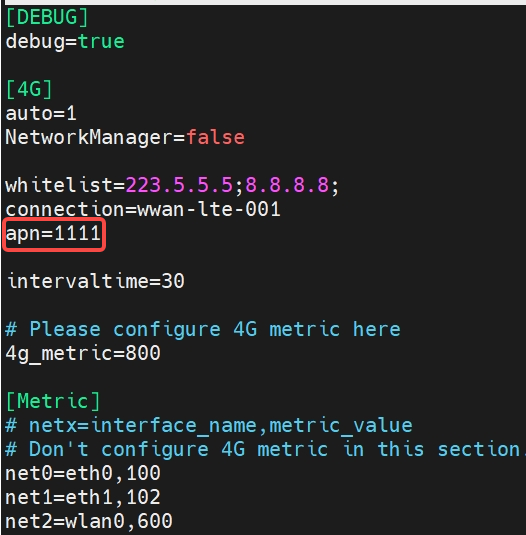
- Execute the following command to restart the device.
sudo reboot
TIP
- If the device is equipped with a 4G indicator, after successfully connecting to the 4G network using the 4G dial-up reconnection software, the status of the 4G indicator can be used to determine network connectivity:
- 4G indicator is on: The device has successfully connected to the 4G network.
- 4G indicator is off: The device is not connected to the network.
- If the device does not have a 4G indicator, after successfully connecting to the 4G network using the 4G dial-up reconnection software, you can check whether the 4G network has been assigned an IP address by executing the
ifconfigcommand:- wwan interface assigned an IP address: The device has successfully connected to the 4G network.
- wwan interface not assigned an IP address: The device failed to connect to the 4G network.
2.3 Configuring 4G Network Parameters
After successfully connecting to the network via the 4G dial-up reconnection software, users can configure the following 4G network parameters as needed:
- DEBUG mode
- NetworkManager dial-up
- Whitelist
- 4G network name
- Interval between two ping attempts
- 4G network priority
- Ping-based network connectivity detection conditions
2.3.1 Configure DEBUG Mode / NetworkManager Dial-Up / Whitelist / Network Name / Interval Between Two Ping Attempts
TIP
Unless required, it is recommended to use the default Quectel-CM dialer instead of NetworkManager, as Quectel-CM provides more stable connectivity.
Steps:
- Execute the following command to access the configuration file.
sudo nano /usr/share/ed-lte-tools/ed_config.ini
- Refer to the table below and modify the corresponding parameter values as needed.
| Item | Description |
|---|---|
| DEBUG mode | By default, DEBUG mode is disabled. When enabled, the logs will display more detailed information such as AT command detection. To activate DEBUG mode, modify the parameter by changing the value from false to true following the "debug= " entry.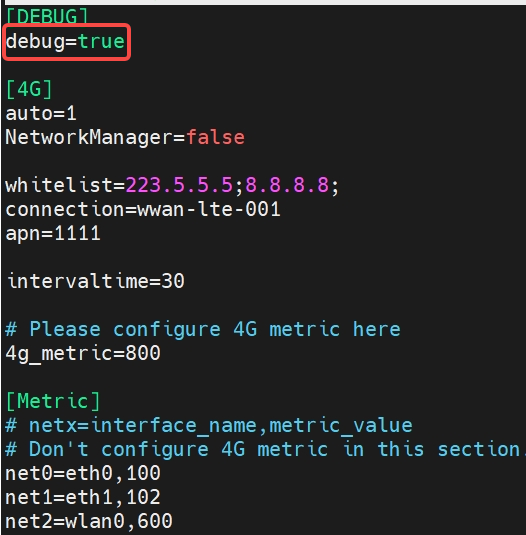 |
| NetworkManager dial-up | To use the NetworkManager service for dial-up, modify the parameter by changing the value from false to true following the "NetworkManager= " entry.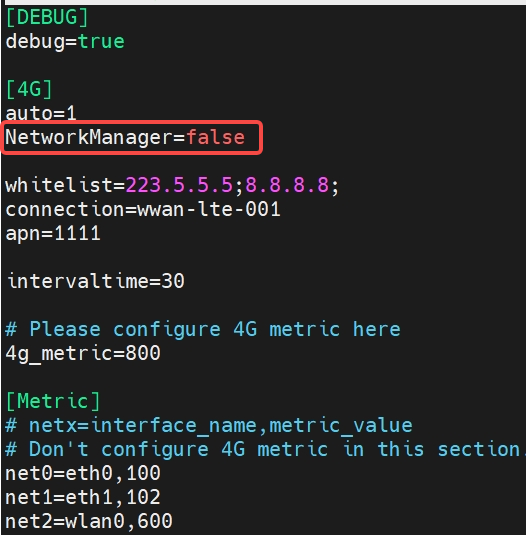 |
| Whitelist | To add IP addresses to the whitelist, append the corresponding IP addresses after "whitelist= ", separating multiple addresses with semicolons (;).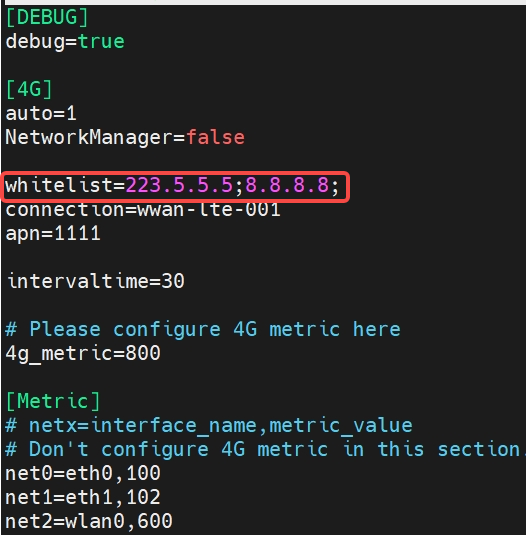 |
| 4G network name | To configure the network name, enter a custom name after "connection= ".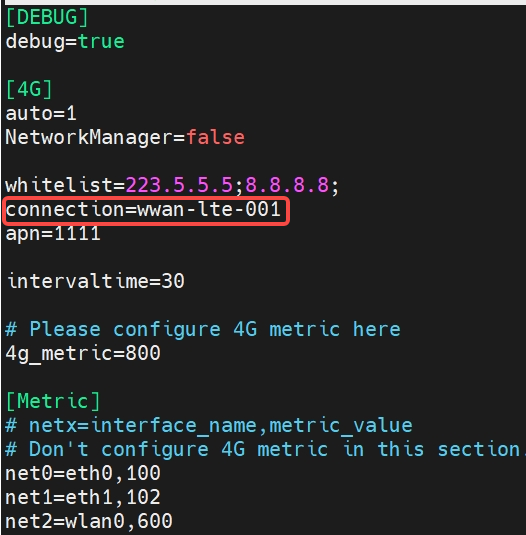 |
| Interval between two ping attempts | To configure the interval time between two ping attempts, enter a custom value after "intervaltime= ".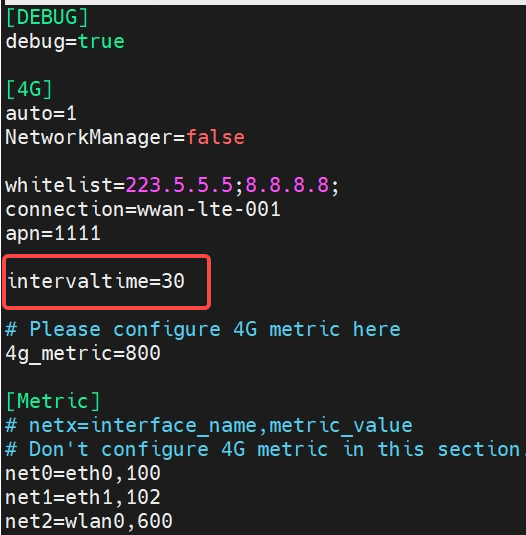 |
After configuring the parameters:
- Press Ctrl+O to save the configuration file.
- Press Enter to confirm the save.
- Press Ctrl+X to exit the editor.
Execute the following command to restart the device and activate the new configuration.
sudo reboot
TIP
If the 4G connection fails or the configuration does not take effect, execute the command journalctl -u ed-lte-tools.service to view detailed logs for troubleshooting.
2.3.2 Configure Network Priority
A single device may have multiple network interfaces, such as a 4G network, wired networks (e.g., eth0 or eth1), and Wi-Fi networks. If you need to prioritize the use of the 4G network, you can adjust the priority of the 4G network to ensure it is prioritized over other connections.
TIP
Connect all relevant network interfaces before adjusting network priority settings.
Steps:
- Execute the following command to view the device's current network interfaces and priority parameters.
route

As shown in the figure above, the device’s network interfaces include eth0, eth1, 4G (wwan0), and Wi-Fi (wlan0). The priority metrics are configured as follows:
4G network (wwan0): Metric = 700 eth0: Metric = 100 eth1: Metric = 101 Wi-Fi (wlan0): Metric = 600 Priority Rule: A lower metric value indicates higher priority. Therefore, the device currently prioritizes the eth0 network connection.
- Execute the following command to access the configuration file.
sudo nano /usr/share/ed-lte-tools/ed_config.ini
- Configure the network "metric" value as needed.
Configure to prioritize 4G network usage
a. To prioritize the 4G network over the eth0 interface, set the value following
4G_metric=to a number less than 100.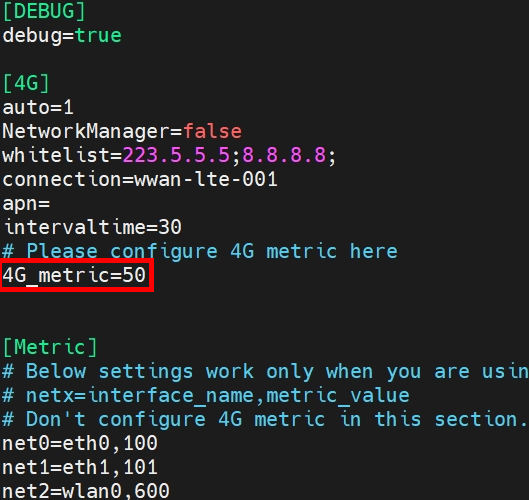
b. After configuring the parameters:
- Press Ctrl+O to save the configuration file.
- Press Enter to confirm the save.
- Press Ctrl+X to exit the editor.
TIP
If the 4G connection fails or the configuration does not take effect, execute the command
journalctl -u ed-lte-tools.serviceto view detailed logs for troubleshooting.Configure to prioritize Ethernet or Wi-Fi network usage
a. Identify the Ethernet or Wi-Fi network interface name to modify.
- net0 corresponds to the eth0 interface.
- net1 corresponds to the eth1 interface.
- net2 corresponds to the Wi-Fi (wlan0) interface.
b. To prioritize the eth1 network over eth0, modify the value after
net1=eth1,to a number less than 100 (e.g., metric=80). This ensures eth1 has a lower metric value than eth0, granting it higher priority in network routing.TIP
If you need to prioritize Wi-Fi network usage, set the value after
net2=wlan0,to a number less than 100.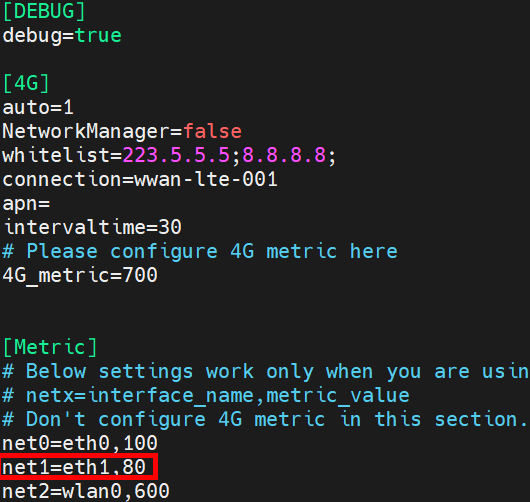
c. After configuring the parameters: - Press Ctrl+O to save the configuration file. - Press Enter to confirm the save. - Press Ctrl+X to exit the editor.
d. After saving and exiting the configuration file, run the following commands in sequence to execute the
ed-network-config.shscript.cd /usr/share/ed-lte-tools && ls sudo ./ed-network-config.sh
- Execute the following command to restart the device and activate the new configuration.
sudo reboot
TIP
If the 4G connection fails or the configuration does not take effect, execute the command journalctl -u ed-lte-tools.service to view detailed logs for troubleshooting.
2.3.3 Configure Ping-based Network Connectivity Detection Conditions
Steps:
- Execute the following command to access the "custom-network-checking" configuration file.
sudo nano /usr/share/ed-lte-tools/custom-network-checking.sh
- Insert your custom script for network connectivity detection conditions within the red box highlighted in the figure below, as indicated.
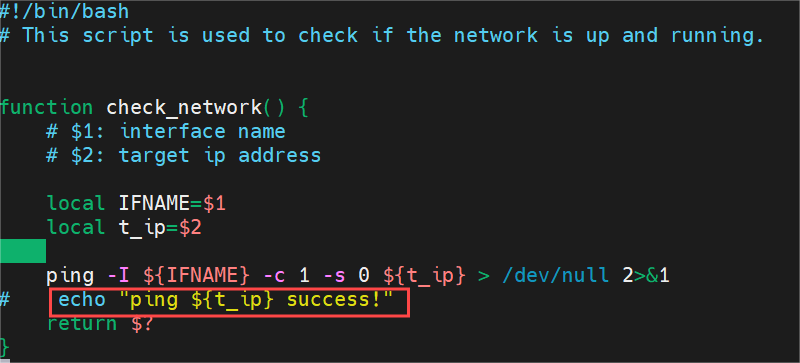
TFNAMEis the 4G network name.- The
t_ipparameter specifies the whitelist IP address. - A
returnvalue of0indicates success, while areturnvalue of1indicates failure.
After configuring the parameters:
- Press Ctrl+O to save the configuration file.
- Press Enter to confirm the save.
- Press Ctrl+X to exit the editor.
Execute the following command to restart the device and activate the new configuration.
sudo reboot
- Execute the following command to view the log information. As illustrated in the figure below, a log entry stating "success" confirms that the settings have been applied correctly.
journalctl -u ed-lte-tools.service

